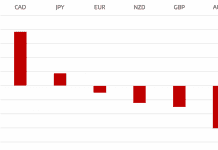
The Jackson Hole Economic Symposium: A Review
The Jackson Hole Economic Symposium is an annual conference sponsored by the Federal Reserve Bank of Kansas City, and it has been held since 1982 in Jackson Hole, Wyoming. Since its inception, the symposium has become increasingly popular (and was even covered by the Wall Street Journal this year). Recently, participants have included everyone from leading players in the financial markets to members of the Federal Bank.
Due to the scale that the symposium now operates on, and the high profile nature of the speakers at the event, it’s always watched closely by market players who are looking to stay ahead of the game. It’s not, for example, uncommon for unexpected remarks to move stock and currency markets, so those following what is being said have the best chance of capitalising on opportunities.
As such, the Jackson Hole Economic Symposium is now a major event in the financial calendar. In this post, we review this year’s event.
Janet Yellen Gives Keynote Address
The conference this year began on August 25th and was held over three days. As usual, it primarily focused on the current state of affairs and what’s effecting not only the US economy, but the global one, too.
The topic of this year’s conference was “designing resilient monetary policy frameworks for the future”, and Janet Yellen (the chairperson of the Federal Reserve) was the keynote speaker.
As such, many of those in attendance were there to hear from the chairperson of the Federal Reserve, in the hope that they’d hear more about the Fed fund rate for 2016 and beyond.
However, as many expected, her remarks when she took to the stage on the Friday of the conference were rather carefully hedged, and she kept any policy decisions that the Fed might be making rather closely guarded.
Addressing the conference, she stated that: “In light of the continued solid performance of the labour market and our outlook for economic activity and inflation, I believe the case for an increase in the federal funds rate has strengthened in recent months.”
As such, she implied that the Fed could soon be increasing short term rates. Although it si possible that this is planned for the September meeting, many analysts and commentators predict that it is far more likely to happen in either the November or December meetings instead.
This is because Yellen was keen to qualify her statement, affirming her belief that: “Our decisions always depend on the degree to which incoming data continues to confirm the Fed’s outlook”.
It is likely that we will receive this “incoming data” within the next month, with a decision made at the Fed’s September meeting based largely on all of the information that the Fed receives.
Based upon Yellen’s remarks, investors and market analysts seem to believe that a rate hike in 2016 is all but inevitable. This is, of course, barring any geo-political events or highly negative sets of data. With a Presidential Election on the horizon, this scenario cannot be ruled out entirely.

What Does this Mean for Investors?
As a result, investors must be cautious. Any rate hike could affect the markets hugely, so it’s important that you know that one could be on the horizon.
This is especially true if you’re going to be spread betting in the run up to Fed meetings or large data announcements, as the markets could fluctuate rapidly. This isn’t to say you should stop spread betting, but you should read market insights from sites like City Index before you do so.
Although the markets can be a dangerous place during times of uncertainty such as this, uncertainty also provides a number of opportunities. So, read your research, and ensure you stay ahead of the game.


































